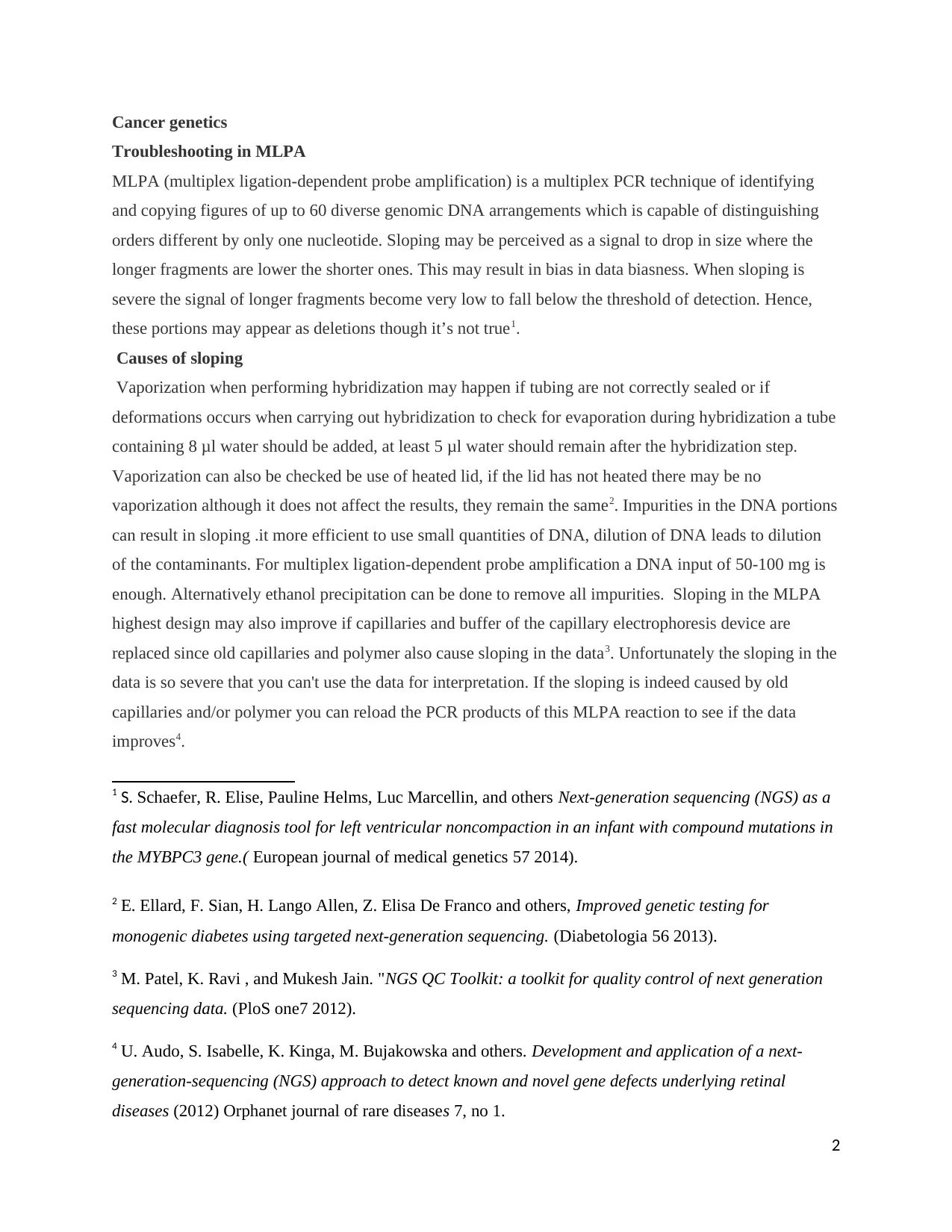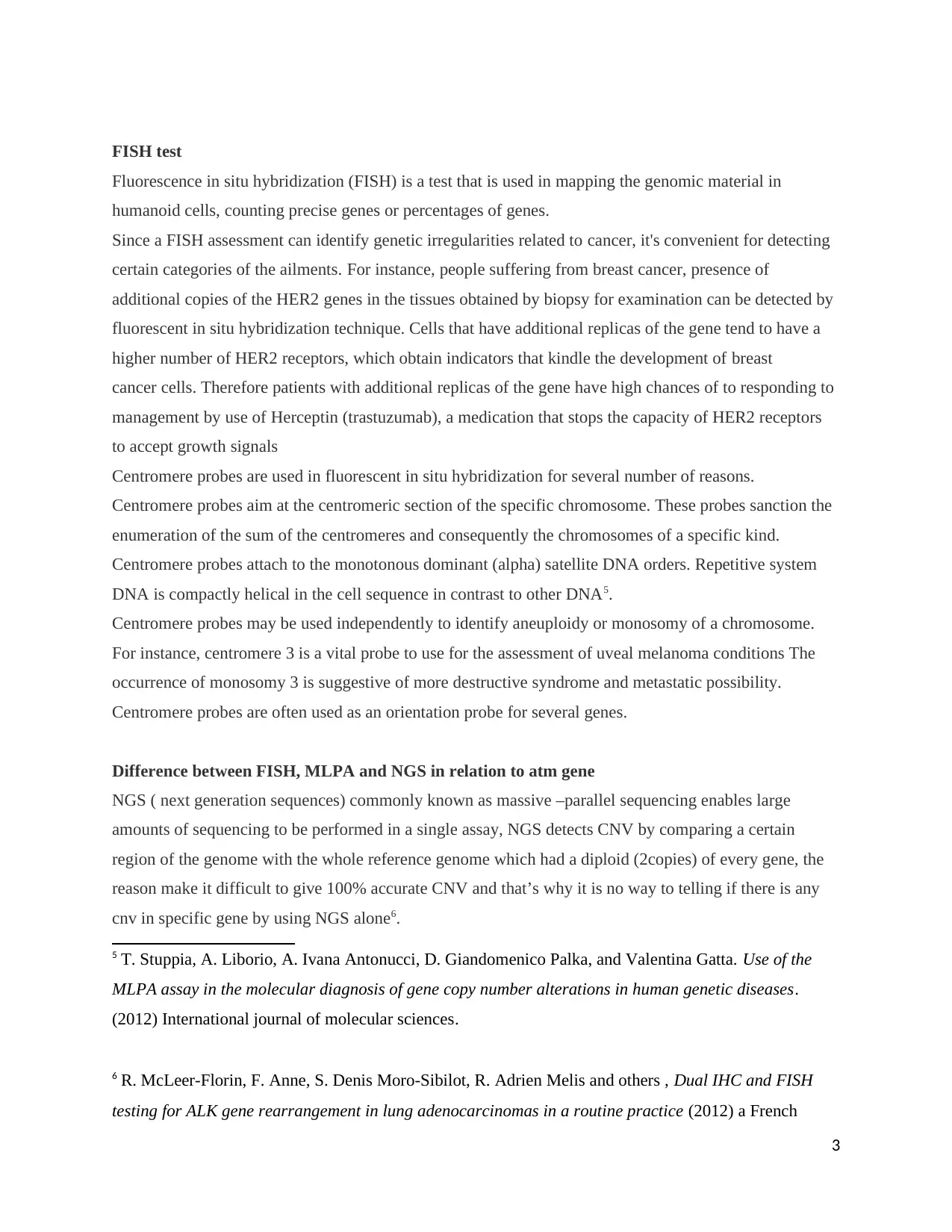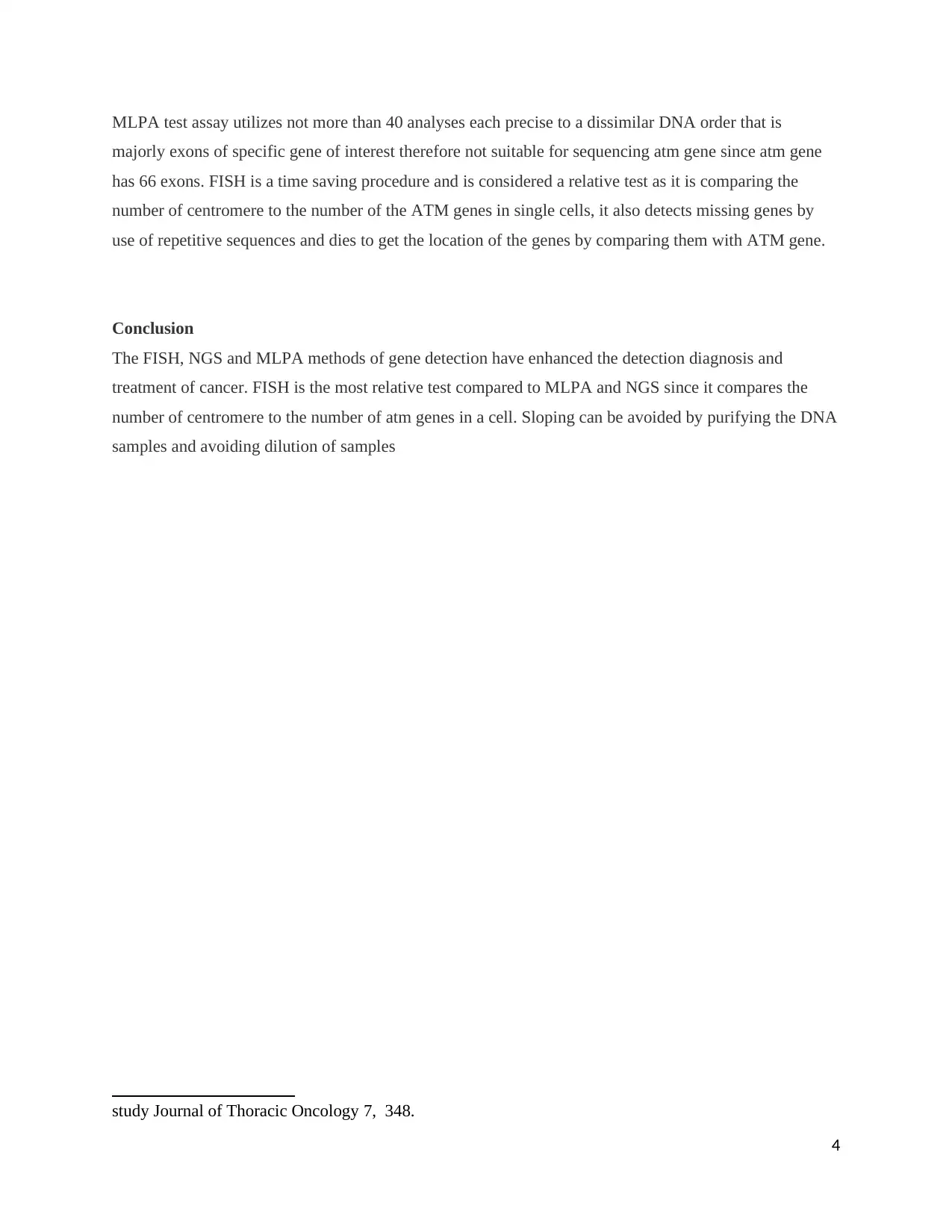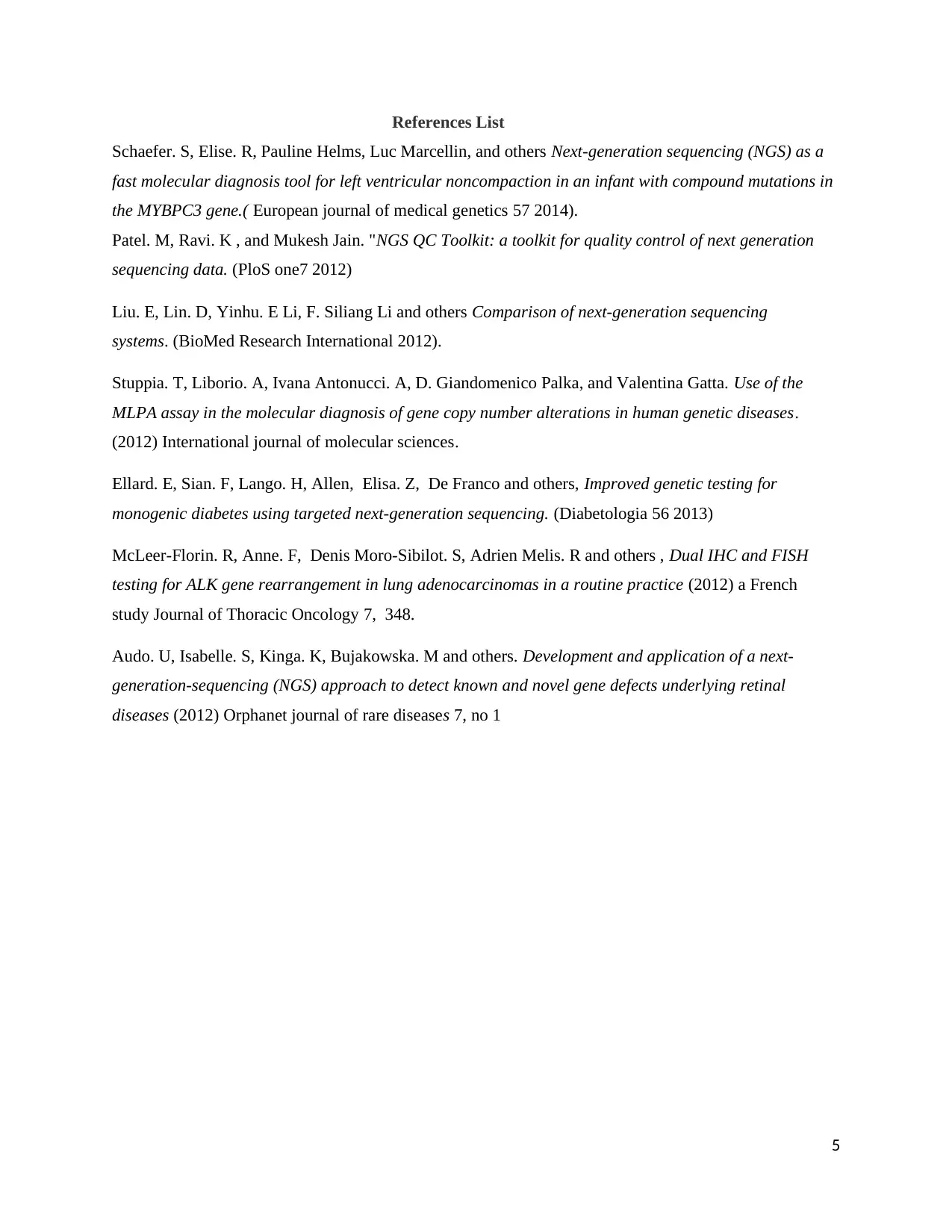A Comparative Analysis of Cancer Genetics Techniques: MLPA, FISH, NGS
VerifiedAdded on 2023/06/03
|5
|1462
|294
Report
AI Summary
This report delves into the realm of cancer genetics, examining three key techniques: MLPA (multiplex ligation-dependent probe amplification), FISH (fluorescence in situ hybridization), and NGS (next-generation sequencing). The report explores the troubleshooting of MLPA, highlighting issues like sloping and potential causes such as vaporization and DNA impurities, and provides solutions to improve data accuracy. It then describes the FISH test, its applications in mapping genomic material, and the use of centromere probes for identifying chromosomal abnormalities. Furthermore, the report compares the three techniques, particularly in relation to the ATM gene, discussing their respective strengths and limitations in gene detection, diagnosis, and treatment of cancer. The conclusion emphasizes the relative nature of FISH compared to MLPA and NGS and underscores the importance of purifying DNA samples to avoid sloping. The report also includes a comprehensive list of references.

CANCER GENETICS
Name
Course title
Institution
date
1
Name
Course title
Institution
date
1
Paraphrase This Document
Need a fresh take? Get an instant paraphrase of this document with our AI Paraphraser

Cancer genetics
Troubleshooting in MLPA
MLPA (multiplex ligation-dependent probe amplification) is a multiplex PCR technique of identifying
and copying figures of up to 60 diverse genomic DNA arrangements which is capable of distinguishing
orders different by only one nucleotide. Sloping may be perceived as a signal to drop in size where the
longer fragments are lower the shorter ones. This may result in bias in data biasness. When sloping is
severe the signal of longer fragments become very low to fall below the threshold of detection. Hence,
these portions may appear as deletions though it’s not true1.
Causes of sloping
Vaporization when performing hybridization may happen if tubing are not correctly sealed or if
deformations occurs when carrying out hybridization to check for evaporation during hybridization a tube
containing 8 μl water should be added, at least 5 μl water should remain after the hybridization step.
Vaporization can also be checked be use of heated lid, if the lid has not heated there may be no
vaporization although it does not affect the results, they remain the same2. Impurities in the DNA portions
can result in sloping .it more efficient to use small quantities of DNA, dilution of DNA leads to dilution
of the contaminants. For multiplex ligation-dependent probe amplification a DNA input of 50-100 mg is
enough. Alternatively ethanol precipitation can be done to remove all impurities. Sloping in the MLPA
highest design may also improve if capillaries and buffer of the capillary electrophoresis device are
replaced since old capillaries and polymer also cause sloping in the data3. Unfortunately the sloping in the
data is so severe that you can't use the data for interpretation. If the sloping is indeed caused by old
capillaries and/or polymer you can reload the PCR products of this MLPA reaction to see if the data
improves4.
1 S. Schaefer, R. Elise, Pauline Helms, Luc Marcellin, and others Next-generation sequencing (NGS) as a
fast molecular diagnosis tool for left ventricular noncompaction in an infant with compound mutations in
the MYBPC3 gene.( European journal of medical genetics 57 2014).
2 E. Ellard, F. Sian, H. Lango Allen, Z. Elisa De Franco and others, Improved genetic testing for
monogenic diabetes using targeted next-generation sequencing. (Diabetologia 56 2013).
3 M. Patel, K. Ravi , and Mukesh Jain. "NGS QC Toolkit: a toolkit for quality control of next generation
sequencing data. (PloS one7 2012).
4 U. Audo, S. Isabelle, K. Kinga, M. Bujakowska and others. Development and application of a next-
generation-sequencing (NGS) approach to detect known and novel gene defects underlying retinal
diseases (2012) Orphanet journal of rare diseases 7, no 1.
2
Troubleshooting in MLPA
MLPA (multiplex ligation-dependent probe amplification) is a multiplex PCR technique of identifying
and copying figures of up to 60 diverse genomic DNA arrangements which is capable of distinguishing
orders different by only one nucleotide. Sloping may be perceived as a signal to drop in size where the
longer fragments are lower the shorter ones. This may result in bias in data biasness. When sloping is
severe the signal of longer fragments become very low to fall below the threshold of detection. Hence,
these portions may appear as deletions though it’s not true1.
Causes of sloping
Vaporization when performing hybridization may happen if tubing are not correctly sealed or if
deformations occurs when carrying out hybridization to check for evaporation during hybridization a tube
containing 8 μl water should be added, at least 5 μl water should remain after the hybridization step.
Vaporization can also be checked be use of heated lid, if the lid has not heated there may be no
vaporization although it does not affect the results, they remain the same2. Impurities in the DNA portions
can result in sloping .it more efficient to use small quantities of DNA, dilution of DNA leads to dilution
of the contaminants. For multiplex ligation-dependent probe amplification a DNA input of 50-100 mg is
enough. Alternatively ethanol precipitation can be done to remove all impurities. Sloping in the MLPA
highest design may also improve if capillaries and buffer of the capillary electrophoresis device are
replaced since old capillaries and polymer also cause sloping in the data3. Unfortunately the sloping in the
data is so severe that you can't use the data for interpretation. If the sloping is indeed caused by old
capillaries and/or polymer you can reload the PCR products of this MLPA reaction to see if the data
improves4.
1 S. Schaefer, R. Elise, Pauline Helms, Luc Marcellin, and others Next-generation sequencing (NGS) as a
fast molecular diagnosis tool for left ventricular noncompaction in an infant with compound mutations in
the MYBPC3 gene.( European journal of medical genetics 57 2014).
2 E. Ellard, F. Sian, H. Lango Allen, Z. Elisa De Franco and others, Improved genetic testing for
monogenic diabetes using targeted next-generation sequencing. (Diabetologia 56 2013).
3 M. Patel, K. Ravi , and Mukesh Jain. "NGS QC Toolkit: a toolkit for quality control of next generation
sequencing data. (PloS one7 2012).
4 U. Audo, S. Isabelle, K. Kinga, M. Bujakowska and others. Development and application of a next-
generation-sequencing (NGS) approach to detect known and novel gene defects underlying retinal
diseases (2012) Orphanet journal of rare diseases 7, no 1.
2

FISH test
Fluorescence in situ hybridization (FISH) is a test that is used in mapping the genomic material in
humanoid cells, counting precise genes or percentages of genes.
Since a FISH assessment can identify genetic irregularities related to cancer, it's convenient for detecting
certain categories of the ailments. For instance, people suffering from breast cancer, presence of
additional copies of the HER2 genes in the tissues obtained by biopsy for examination can be detected by
fluorescent in situ hybridization technique. Cells that have additional replicas of the gene tend to have a
higher number of HER2 receptors, which obtain indicators that kindle the development of breast
cancer cells. Therefore patients with additional replicas of the gene have high chances of to responding to
management by use of Herceptin (trastuzumab), a medication that stops the capacity of HER2 receptors
to accept growth signals
Centromere probes are used in fluorescent in situ hybridization for several number of reasons.
Centromere probes aim at the centromeric section of the specific chromosome. These probes sanction the
enumeration of the sum of the centromeres and consequently the chromosomes of a specific kind.
Centromere probes attach to the monotonous dominant (alpha) satellite DNA orders. Repetitive system
DNA is compactly helical in the cell sequence in contrast to other DNA5.
Centromere probes may be used independently to identify aneuploidy or monosomy of a chromosome.
For instance, centromere 3 is a vital probe to use for the assessment of uveal melanoma conditions The
occurrence of monosomy 3 is suggestive of more destructive syndrome and metastatic possibility.
Centromere probes are often used as an orientation probe for several genes.
Difference between FISH, MLPA and NGS in relation to atm gene
NGS ( next generation sequences) commonly known as massive –parallel sequencing enables large
amounts of sequencing to be performed in a single assay, NGS detects CNV by comparing a certain
region of the genome with the whole reference genome which had a diploid (2copies) of every gene, the
reason make it difficult to give 100% accurate CNV and that’s why it is no way to telling if there is any
cnv in specific gene by using NGS alone6.
5 T. Stuppia, A. Liborio, A. Ivana Antonucci, D. Giandomenico Palka, and Valentina Gatta. Use of the
MLPA assay in the molecular diagnosis of gene copy number alterations in human genetic diseases.
(2012) International journal of molecular sciences.
6 R. McLeer-Florin, F. Anne, S. Denis Moro-Sibilot, R. Adrien Melis and others , Dual IHC and FISH
testing for ALK gene rearrangement in lung adenocarcinomas in a routine practice (2012) a French
3
Fluorescence in situ hybridization (FISH) is a test that is used in mapping the genomic material in
humanoid cells, counting precise genes or percentages of genes.
Since a FISH assessment can identify genetic irregularities related to cancer, it's convenient for detecting
certain categories of the ailments. For instance, people suffering from breast cancer, presence of
additional copies of the HER2 genes in the tissues obtained by biopsy for examination can be detected by
fluorescent in situ hybridization technique. Cells that have additional replicas of the gene tend to have a
higher number of HER2 receptors, which obtain indicators that kindle the development of breast
cancer cells. Therefore patients with additional replicas of the gene have high chances of to responding to
management by use of Herceptin (trastuzumab), a medication that stops the capacity of HER2 receptors
to accept growth signals
Centromere probes are used in fluorescent in situ hybridization for several number of reasons.
Centromere probes aim at the centromeric section of the specific chromosome. These probes sanction the
enumeration of the sum of the centromeres and consequently the chromosomes of a specific kind.
Centromere probes attach to the monotonous dominant (alpha) satellite DNA orders. Repetitive system
DNA is compactly helical in the cell sequence in contrast to other DNA5.
Centromere probes may be used independently to identify aneuploidy or monosomy of a chromosome.
For instance, centromere 3 is a vital probe to use for the assessment of uveal melanoma conditions The
occurrence of monosomy 3 is suggestive of more destructive syndrome and metastatic possibility.
Centromere probes are often used as an orientation probe for several genes.
Difference between FISH, MLPA and NGS in relation to atm gene
NGS ( next generation sequences) commonly known as massive –parallel sequencing enables large
amounts of sequencing to be performed in a single assay, NGS detects CNV by comparing a certain
region of the genome with the whole reference genome which had a diploid (2copies) of every gene, the
reason make it difficult to give 100% accurate CNV and that’s why it is no way to telling if there is any
cnv in specific gene by using NGS alone6.
5 T. Stuppia, A. Liborio, A. Ivana Antonucci, D. Giandomenico Palka, and Valentina Gatta. Use of the
MLPA assay in the molecular diagnosis of gene copy number alterations in human genetic diseases.
(2012) International journal of molecular sciences.
6 R. McLeer-Florin, F. Anne, S. Denis Moro-Sibilot, R. Adrien Melis and others , Dual IHC and FISH
testing for ALK gene rearrangement in lung adenocarcinomas in a routine practice (2012) a French
3
⊘ This is a preview!⊘
Do you want full access?
Subscribe today to unlock all pages.

Trusted by 1+ million students worldwide

MLPA test assay utilizes not more than 40 analyses each precise to a dissimilar DNA order that is
majorly exons of specific gene of interest therefore not suitable for sequencing atm gene since atm gene
has 66 exons. FISH is a time saving procedure and is considered a relative test as it is comparing the
number of centromere to the number of the ATM genes in single cells, it also detects missing genes by
use of repetitive sequences and dies to get the location of the genes by comparing them with ATM gene.
Conclusion
The FISH, NGS and MLPA methods of gene detection have enhanced the detection diagnosis and
treatment of cancer. FISH is the most relative test compared to MLPA and NGS since it compares the
number of centromere to the number of atm genes in a cell. Sloping can be avoided by purifying the DNA
samples and avoiding dilution of samples
study Journal of Thoracic Oncology 7, 348.
4
majorly exons of specific gene of interest therefore not suitable for sequencing atm gene since atm gene
has 66 exons. FISH is a time saving procedure and is considered a relative test as it is comparing the
number of centromere to the number of the ATM genes in single cells, it also detects missing genes by
use of repetitive sequences and dies to get the location of the genes by comparing them with ATM gene.
Conclusion
The FISH, NGS and MLPA methods of gene detection have enhanced the detection diagnosis and
treatment of cancer. FISH is the most relative test compared to MLPA and NGS since it compares the
number of centromere to the number of atm genes in a cell. Sloping can be avoided by purifying the DNA
samples and avoiding dilution of samples
study Journal of Thoracic Oncology 7, 348.
4
Paraphrase This Document
Need a fresh take? Get an instant paraphrase of this document with our AI Paraphraser

References List
Schaefer. S, Elise. R, Pauline Helms, Luc Marcellin, and others Next-generation sequencing (NGS) as a
fast molecular diagnosis tool for left ventricular noncompaction in an infant with compound mutations in
the MYBPC3 gene.( European journal of medical genetics 57 2014).
Patel. M, Ravi. K , and Mukesh Jain. "NGS QC Toolkit: a toolkit for quality control of next generation
sequencing data. (PloS one7 2012)
Liu. E, Lin. D, Yinhu. E Li, F. Siliang Li and others Comparison of next-generation sequencing
systems. (BioMed Research International 2012).
Stuppia. T, Liborio. A, Ivana Antonucci. A, D. Giandomenico Palka, and Valentina Gatta. Use of the
MLPA assay in the molecular diagnosis of gene copy number alterations in human genetic diseases.
(2012) International journal of molecular sciences.
Ellard. E, Sian. F, Lango. H, Allen, Elisa. Z, De Franco and others, Improved genetic testing for
monogenic diabetes using targeted next-generation sequencing. (Diabetologia 56 2013)
McLeer-Florin. R, Anne. F, Denis Moro-Sibilot. S, Adrien Melis. R and others , Dual IHC and FISH
testing for ALK gene rearrangement in lung adenocarcinomas in a routine practice (2012) a French
study Journal of Thoracic Oncology 7, 348.
Audo. U, Isabelle. S, Kinga. K, Bujakowska. M and others. Development and application of a next-
generation-sequencing (NGS) approach to detect known and novel gene defects underlying retinal
diseases (2012) Orphanet journal of rare diseases 7, no 1
5
Schaefer. S, Elise. R, Pauline Helms, Luc Marcellin, and others Next-generation sequencing (NGS) as a
fast molecular diagnosis tool for left ventricular noncompaction in an infant with compound mutations in
the MYBPC3 gene.( European journal of medical genetics 57 2014).
Patel. M, Ravi. K , and Mukesh Jain. "NGS QC Toolkit: a toolkit for quality control of next generation
sequencing data. (PloS one7 2012)
Liu. E, Lin. D, Yinhu. E Li, F. Siliang Li and others Comparison of next-generation sequencing
systems. (BioMed Research International 2012).
Stuppia. T, Liborio. A, Ivana Antonucci. A, D. Giandomenico Palka, and Valentina Gatta. Use of the
MLPA assay in the molecular diagnosis of gene copy number alterations in human genetic diseases.
(2012) International journal of molecular sciences.
Ellard. E, Sian. F, Lango. H, Allen, Elisa. Z, De Franco and others, Improved genetic testing for
monogenic diabetes using targeted next-generation sequencing. (Diabetologia 56 2013)
McLeer-Florin. R, Anne. F, Denis Moro-Sibilot. S, Adrien Melis. R and others , Dual IHC and FISH
testing for ALK gene rearrangement in lung adenocarcinomas in a routine practice (2012) a French
study Journal of Thoracic Oncology 7, 348.
Audo. U, Isabelle. S, Kinga. K, Bujakowska. M and others. Development and application of a next-
generation-sequencing (NGS) approach to detect known and novel gene defects underlying retinal
diseases (2012) Orphanet journal of rare diseases 7, no 1
5
1 out of 5
Your All-in-One AI-Powered Toolkit for Academic Success.
+13062052269
info@desklib.com
Available 24*7 on WhatsApp / Email
![[object Object]](/_next/static/media/star-bottom.7253800d.svg)
Unlock your academic potential
Copyright © 2020–2025 A2Z Services. All Rights Reserved. Developed and managed by ZUCOL.